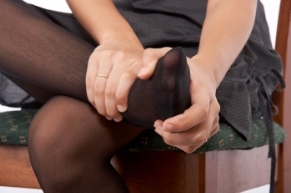Bunion Treatment
Bunion Surgery in Houston & Sugarland
Normal toes extend straight out from your foot. If your big toe shifts
inside while your metatarsophalangeal joint moves the opposite direction,
you have a bunion. At first, bunions seem relatively harmless, but as
time goes on these bunions will cause considerable pain and discomfort.
It can get so bad that if, untreated, a bunion may leave you unable to
walk properly. Instead of enduring the pain, call the Advanced Foot &
Ankle Specialists of Sugar Land. We offer non-invasive bunion treatments
as well as sophisticated bunion surgery for those with advanced cases.
 Bunion Causes and Symptoms
Bunion Causes and Symptoms
If one or both of your parents had or have bunions, there's a good
chance you'll develop a bunion, too. The development of bunions depends
largely on foot type, which is passed down from parent to child. Bunions
also develop as a result of uncomfortable footwear—particularly
high-heel shoes with narrow toe boxes. Bunion symptoms include redness
and swelling of the big toe, irritation on the first or second toe, and
a large bump at the base of the big toe.
Signs that You Need Bunion Surgery
If you have a bunion, it's important that you visit a foot doctor.
Most bunions can be treated without surgery, though bunion surgery may
be necessary if you exhibit the following signs.
-
Difficulty Walking: If your bunions cause so much pain that you have trouble walking or performing
other everyday activities, surgery may be your best option.
-
Toe Stiffness: A normal big toe should bend and straighten without pain. If you are unable
to move your toe, ask your foot doctor about surgery.
-
Ineffective Conservative Treatment: Surgery should always be a last resort. Before surgery, your foot doctor
will likely recommend special footwear, anti-inflammatory drugs, and other
conservative treatments. If these treatments fail, surgery is your only
option left.
Surgical Techniques
Like most other aspects of medical science, bunion surgery has come a long
way in recent years. The earlier you visit a foot doctor, the less invasive
surgery you will require.
-
Bunionectomy: Patients with relatively minor deformities may undergo a simple bunionectomy,
during which the wayward bone section is cut and removed. A bunionectomy
involves a minimal incision, and allows the patient to quickly get back
on her feet.
-
Joint Realignment: If you have a more severe deformity, your foot doctor may opt for one of
several different kinds of joint realignment. The utilization of a pain
pump can help manage pain during surgery.